Are There Woodpeckers in Georgia? – Have You Spotted a Woodpecker Lately?
Wandering around the coastlines, wetlands, and woodlands of Georgia is a dream come true for many birdwatchers. They can spot as many as 430 different species of birds, including nine species of woodpeckers in Georgia.
Woodpeckers are non-predatory birds of the family Picidae. These birds are smart, intelligent, and really friendly with humans. If you have bird feeders in your backyard, you might see some woodpeckers regularly paying you a visit.
These birds, as can be guessed from the name, find their habitat in woodlands. They are mostly seen inhabiting tropical rainforests. Owing to Geogia’s sub-tropical weather, woodpeckers are often seen in this state.
List of the Woodpeckers in Georgia
These are the woodpecker birds along with their scientific names that you can spot in Georgia –
- Yellow-bellied Sapsucker (Sphyrapicus varius)
- Red-headed Woodpecker (Melanerpes erythrocephalus)
- Red-bellied Woodpecker (Melanerpes carolinus)
- Downy Woodpecker (Picoides pubescens)
- Hairy Woodpecker (Leuconotopicus villosus)
- Reed-cockaded Woodpecker (Leuconotopicus borealis)
- Pileated Woodpecker (Dryocopus pileatus)
- Northern Flicker (Colaptes auratus)
- Ivory-billed Woodpecker (Campephilus principalis)
Species Profile of the Woodpeckers in Georgia
For bird lovers like you, we have below a detailed species profile of woodpeckers living in Georgia with their appearances, habits, and characteristics. Keep reading to find out about them!
1. Yellow-Bellied Sapsucker (Sphyrapicus Varius)

| Length | 7.1-8.7 in |
| Weight | 1.5-1.9 oz |
| Wingspan | 13.4-15.8 in |
Commonly Found in
The yellow-bellied sapsuckers are migratory birds found in Georgia, visiting the state between October and April.
These birds prefer coniferous woodlands and hardwood. You can usually spot them in half-open areas in forests and some suburban areas.
This species of woodpecker love maples and birches. They are also seen in young deciduous forests where the trees have creative sap wells, an integral part of their diet.
Behavior and Characteristics
Yellow-bellied sapsuckers are small like a robin bird. As their name suggests, their bellies are yellowish in color. Their foreheads, on the other hand, have bold red colored marks. Otherwise, their feathers are black and white.
The males have a red throat while the females have a white throat. As mentioned above, their main source of food is sap. Their diet also includes insects, spiders, and ants.
Fun and Interesting Fact
When the yellow-bellied sapsuckers drill sap wells, their usual drilling makes a sound similar to morse code.
2. Red-Headed Woodpecker (Melanerpes Erythrocephalus)
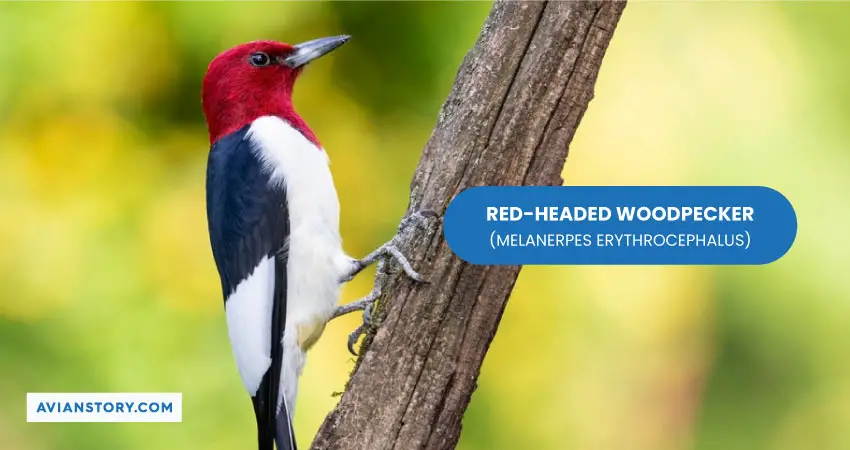
| Length | 7.5-9.1 in |
| Weight | 2.0-3.2 oz |
| Wingspan | 16.5 in |
Commonly Found in
Red-headed woodpeckers are a common sight in Georgia. These birds like open or half-open areas of woodlands and forest clearings.
They are also seen in pine savannas and swamps. But unfortunately, the population of this bird has been declining throughout the years due to being shot down by humans.
Behavior and Characteristics
This species of woodpecker has a big redhead. Their bill is also bigger than other woodpecker species while their body is covered with black and white markings.
Red-headed woodpeckers’ white undersides and short tails are quite distinctive physical traits, which makes them quite easy to spot, even by amateurs.
These birds eat mostly plant-based foods like seeds, berries, and nuts. Sometimes they are also seen eating insects like honeybees, beetles, and grasshoppers.
Fun and Interesting Fact
This bird is considered one of the prettiest of its type due to its red head. They are also the only woodpecker birds that store food.
3. Red-Bellied Woodpecker (Melanerpes Carolinus)

| Length | 9.4 in (24 cm) |
| Weight | 2.0-3.2 oz (56-91 g) |
| Wingspan | 13.0-16.5 in (33-42 cm) |
Commonly Found in
The red-bellied woodpeckers are a frequent sight at bird feeders. Those who live near woodlands can spot these birds in their yards.
They are found throughout the year in Georgia. Besides chirping away at bird feeders, these birds also like to remain perched on the thick main branches of trees of trunks.
Behavior and Characteristics
Red-bellied woodpeckers have a peach and red-hued cap and nape. The feathers on their back are marked in black and white colors. Even their tails are monochromatic, which lightly contrasts their cream-toned body below.
Their name comes from the pale red belly they have, although it may not be easily visible. These birds feed on seeds from fruits, nuts, and grasses. They also eat insects and spiders like other woodpeckers.
Fun and Interesting Fact
The call of this bird is very distinct, so you can identify with its sound before you can spot them, especially in the spring and summer seasons.
4. Downy Woodpecker (Picoides Pubescens)
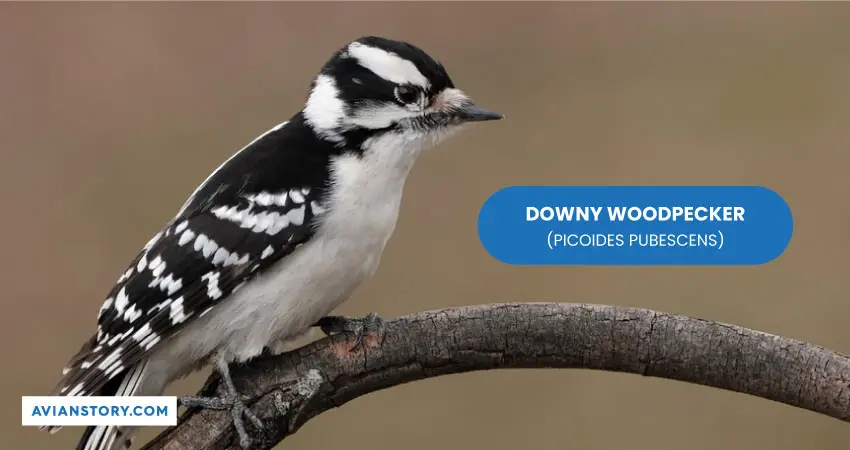
| Length | 5.5-6.7 in (14-17 cm) |
| Weight | 0.7-1.0 oz (21-28 g) |
| Wingspan | 9.8-11.8 in (25-30 cm) |
Commonly Found in
The downy woodpeckers are found in Georgia throughout the year. Their beaks are quite smaller than the other species of woodpeckers.
Downy woodpeckers are one of the more permanent woodpecker species in the State of Georgia. They are frequent in open woodlands, suburban areas, parks, and orchards. These birds also prefer hanging around near bird feeders.
Behavior and Characteristics
You can identify between male and female of this species by the color of their nape. The males have a red spot on their napes, while the females don’t. Both genders’ feathers have a black-and-white pattern.
The diet of this species mainly consists of insects that are found inside the wood. They also eat ants, caterpillars, berries, grains, etc.
Fun and Interesting Fact
The drumming sound of this bird species is really fast. Many mistakes it for the wind rather than the interval flapping sound of wings.
5. Hairy Woodpecker (Leuconotopicus Villosus)

| Length | 7.1-10.2 in (18-26 cm) |
| Weight | 1.4-3.4 oz (40-95 g) |
| Wingspan | 13.0-16.1 in (33-41 cm) |
Commonly Found in
The Hairy woodpeckers are seen in forest woodlands. They are also spotted in suburban yards, parks, orchards, and cemeteries.
Even though they prefer mature forests, they have adapted well to urban human places, so you’ll find them flying around in your yard.
Behavior and Characteristics
These birds are often compared to soldiers because of their straight-back posture. Their heads are clean and striped.
Hair woodpeckers possess the same red nape as Downy woodpeckers, however this feature is absent within the females of their species. Besides, they are larger than downy woodpeckers. The bills are longer, while their head is a bit square-like.
Fun and Interesting Fact
Hairy woodpeckers are quite similar to downy woodpeckers. That’s why it is often confusing to say which one is which.
6. Red-Cockaded Woodpecker (Leuconotopicus Borealis)
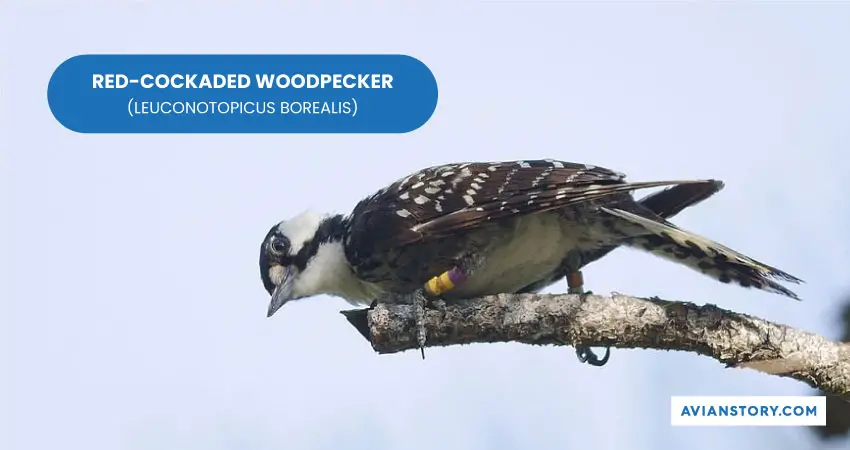
| Length | 7.9-9.1 in (20-23 cm) |
| Weight | 1.5-1.8 oz (42-52 g) |
| Wingspan | 14.2 in (36 cm) |
Commonly Found in
The main habitat of the Red-cockaded woodpeckers is old longleaf pine forests. Unfortunately, they are losing their habitat and reducing in population.
While these birds were common in Georgia once, they are now quite rarely seen.
Behavior and Characteristics
Despite the birds having been named Red-cockaded, they don’t have any red feathers on their body. Their feathers are white and brownish. While many argue that the red dot behind their eyes has earned them the name, it is quite small and not very distinctive.
Fun and Interesting Fact
These birds have a really unique way of protecting themselves from snakes. Their sap wells are drilled at the edge of their nest so that the sap will leak, and the snakes will not be able to climb the tree.
7. Pileated Woodpecker (Dryocopus Pileatus)
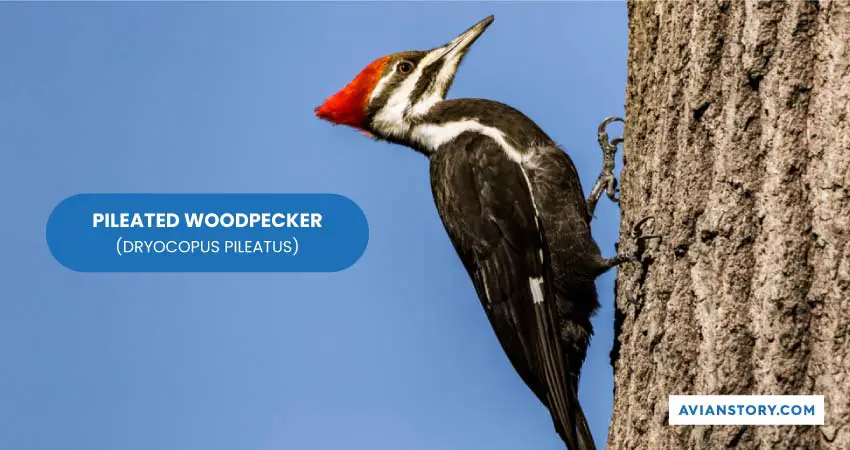
| Length | 15.8-19.3 in (40-49 cm) |
| Weight | 8.8-12.3 oz (250-350 g) |
| Wingspan | 26.0-29.5 in (66-75 cm) |
Commonly Found in
The pileated woodpeckers are seen in big, mature forests. They prefer dead trees or ones that have fallen over time.
The rotten woods are perfect for digging through to find their food. Pileated Woodpeckers also prefer half-open woodlands. No matter the type of land, these species like to build its home in large trees.
Behavior and Characteristics
This woodpecker is one the biggest of its kind. The size of a pileated woodpecker is nearly the size of a crow.
They are also mostly black in appearance with a white strip on their body. The undersides of their wings are also white.
Male birds of this species have a red stripe on their face, which the females do not possess. These birds eat beetles, larvae, termites, and insects, along with other fruits and nuts. But their main diet includes carpenter ants they find in dead trees.
Fun and Interesting Fact
Pileated Woodpeckers are one of the largest woodpecker species out there. They are really easy to distinguish because of their size and appearance. However, they are quite rare to spot.
8. Northern Flicker (Colaptes Auratus)
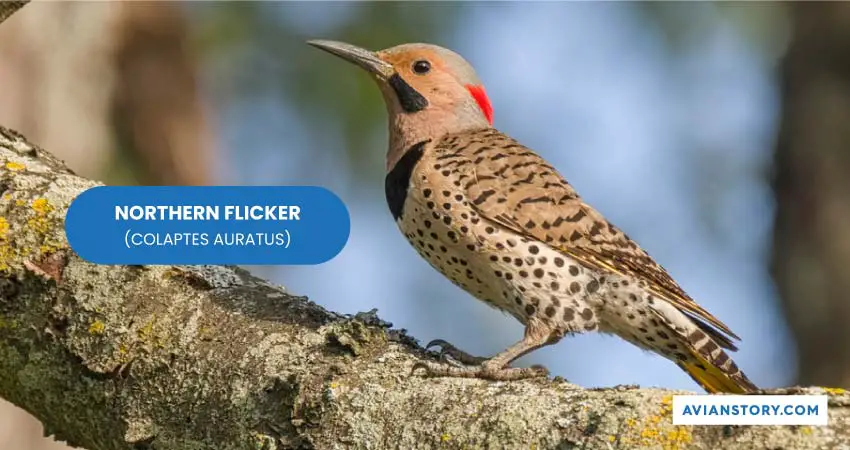
Commonly Found in
The Northern Flicker woodpeckers are fairly common in Georgia. They are seen in open woodlands, clear forest edges, and parks in suburban areas. You’ll also find them in your yards, but they prefer birdbaths more than bird feeders.
When searching for food, Northern Flicker woodpeckers like flying around in groups.
Behavior and Characteristics
The Northern Flicker woodpeckers are very beautiful birds. They have warm brown feathers with black spots on their backside and wings.
Their bellies also contain small spots. The undersides of their tails and wings are a bright yellow. They have peach and blue hints underside their body and also on their heads, which make them so beautiful.
These birds mainly eat insects like ants and beetles from the ground. They also look for insect larvae. During winter, they eat mostly fruits and seeds.
Fun and Interesting Fact
These handsome birds act really differently from other woodpeckers. For example, they are seen on the ground more than perched on tree branches.
9. Ivory-Billed Woodpecker (Campephilus Principalis)
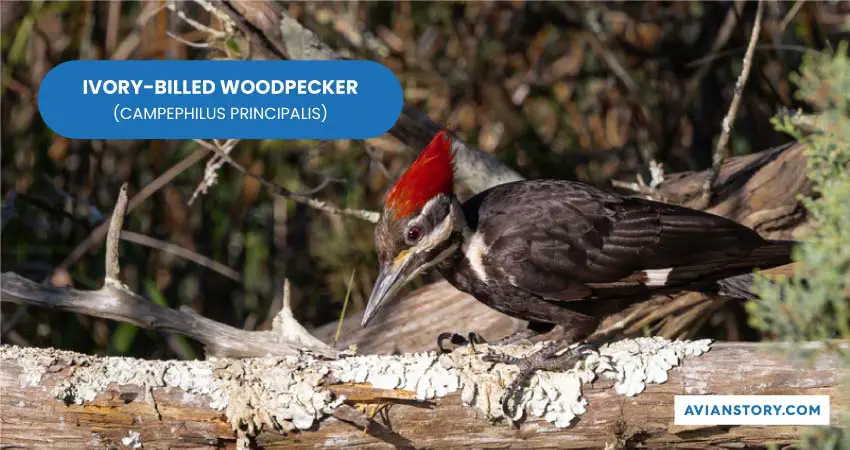
Commonly Found in
The ivory-billed woodpeckers are seen in many parts of Georgia. However, these big birds are becoming extinct now due to the loss of their habitat.
They used to live in higher lands and mature forests. Due to their diet, the habitat of these birds remains confined around old, dead trees.
Behavior and Characteristics
Ivory-billed woodpeckers are quite huge, even larger than crows. In fact, they are the largest woodpeckers seen in Northern America.
Their bills are elongated and thick, with the color being mostly black. Their source of food comes from fallen trees or dead trees, where they find ants and beetles, and other insects.
They eat beetle larvae and other invertebrates. These birds can also eat fruits like berries, acorns, etc.
Fun and Interesting Fact
The ivory-billed birds are the largest kind of woodpeckers seen. Although they are not predatory birds, they do have a deadly gleam in their appearance.
Final Words
Many kinds of woodpeckers are largely seen in Georgia due to its climate. Unfortunately, due to climate change and other man-made reasons, most of these woodpeckers are losing their homes and sources of food.
Species of woodpeckers in Georgia that were once quite common have now become a rare sight.
If you want to spot them in your backyard, you can keep some bird feeders like suet feeders which they love. Some species prefer bird baths over feeders, so you can install them as well.
Planting different types of fruit trees like berries also attracts these beautiful birds.
Woodpeckers Found in Some Other States:
Resources:

